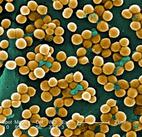 | ||||
Prokaryotes: Meet the Microbes
Practice Test Questions II
Virtual Microbiology Classroom of Science Prof Online
Prokaryotic Microbes Test Questions - Part 2
SPO VIRTUAL CLASSROOMS
 | ||||||
1. If a
causes infectious disease, we know that it is a member of ...
a. Eukarya
b. Eubacteria
c. Archea
d. b & c
e. could be a member of any of the domains listed.
a. vegetative cells
vegetative cells
b. endospores
endospores
3. Of the following bacteria, which are Gram-positive?
#1. Streptococcus mutans
#2. Escherichia coli
#3. Staphylococcus epidermidis
#4. Salmonella pullorum
#5. Bacillus anthracis
#6. Clostridium difficile
a. #1 & #2 b. #2 & #4 c. #3 & #4 d. #1, #3 & #4 e. #1, #3, #5 & #6
4. Tetanus is cause by a bacterium that:
5. What does it mean for a bacterium to be considered a facultative anaerobe?
a. it cannot exist in the presence of oxygen
b. it must have oxygen to exist
c. it requires a salty environment
d. it requires a very hot environment
e. it can exist with or without oxygen
The following questions, from the Virtual Microbiology Classroom, are designed to help students better understand this topic. All questions are based on material that can be found on the Prokaryotes: Meet the Microbes Lecture Main Page.
Pathogenic bacteria
Staphylococcus aureus, also known as Golden Staph.
Page last updated: 1/2016
You have free access to a large collection of materials used in a college-level introductory microbiology course. The Virtual Microbiology Classroom provides a wide range of free educational resources including PowerPoint Lectures, Study Guides, Review Questions and Practice Test Questions.
 | ||||
The VMC offers homework assignments based on Radiolab podcasts.
RADIOLAB PODCASTS:
HOMEWORK ASSIGNMENTS:
6. The three forms of anthrax include:
7. A MacConkey's media plate inoculated with the bacteria Salmonella would:
8. Which species of bacteria would we use Blood Agar to identify?
a. Bacillus anthracis
Bacillus anthracis
b. Staphylococcus aureus
c. Mycobacterium smegmatis
d. Streptococcus pyogenes

e. Escherichia coli
9. Which microbe would you most likely find in large numbers in a hypertonic environment?
a. Mycobacterium b. Mycoplasma 
 c. Staphylococcus
c. Staphylococcus
d. Bacillus e. Salmonella
10. Where would you most likely find a halophile?
Click here for MORE Prokaryote - Meet the Microbe Practice Test Questions.





